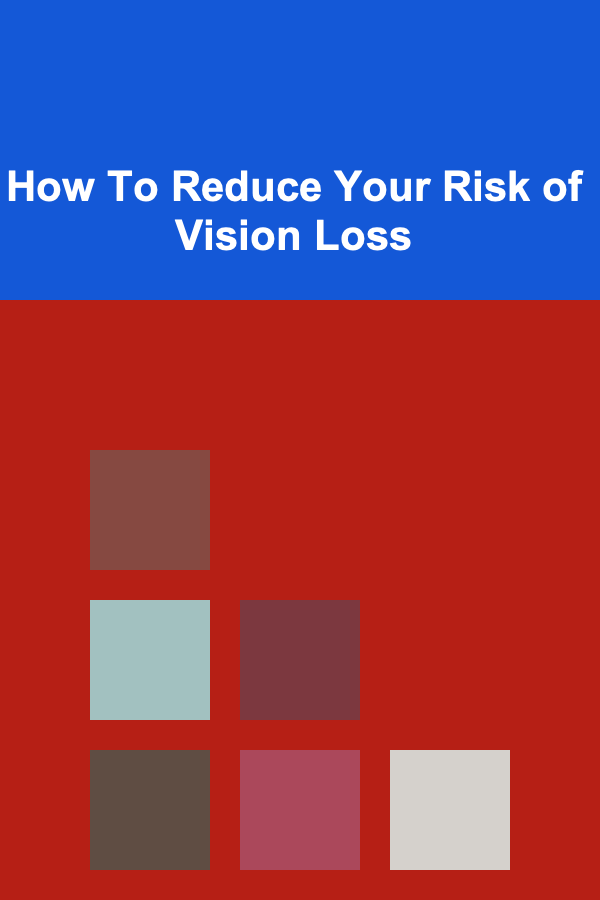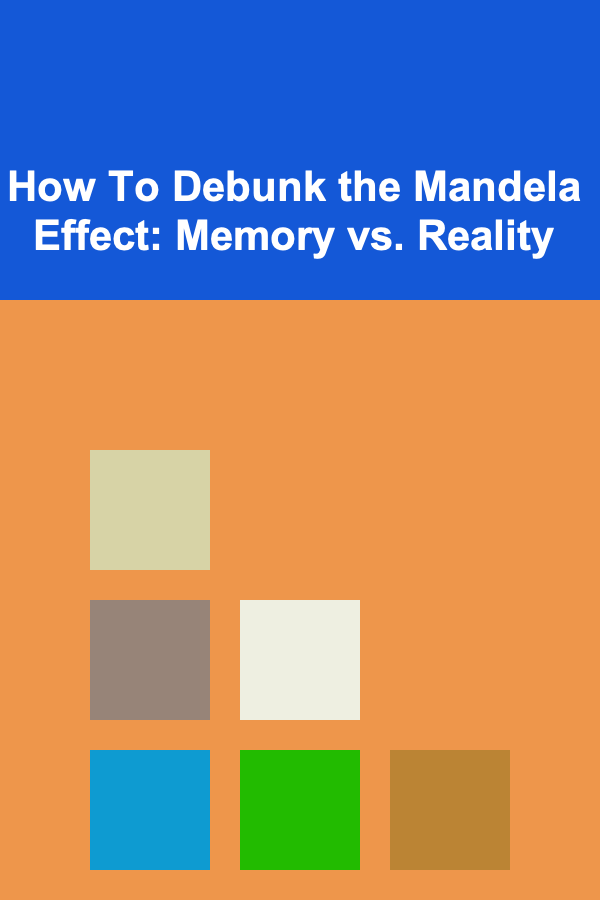
How To Reduce Your Risk of Vision Loss
ebook include PDF & Audio bundle (Micro Guide)
$12.99$9.99
Limited Time Offer! Order within the next:

Vision loss is a significant concern for many people as they age, but it can also be caused by various factors that are preventable or manageable. Whether it's a result of a medical condition, lifestyle choices, or environmental factors, the impact of vision loss can significantly affect one's quality of life. Fortunately, there are steps you can take to reduce your risk of losing vision. This comprehensive article will explore the causes of vision loss, preventive measures, lifestyle changes, and medical interventions that can help safeguard your eyesight.
Understanding Vision Loss
Vision loss can manifest in various forms, ranging from mild blurriness to complete blindness. The causes of vision loss are diverse, but the most common ones are age-related macular degeneration (AMD), diabetic retinopathy, glaucoma, cataracts, and refractive errors like nearsightedness and farsightedness. Understanding the risk factors for these conditions and how they develop is key to taking preventative action.
1. Age-Related Macular Degeneration (AMD)
AMD is one of the leading causes of vision loss in people over the age of 50. It affects the macula, the part of the retina responsible for central vision. There are two types: dry AMD, which progresses slowly, and wet AMD, which can lead to rapid and severe vision loss. Smoking, a poor diet, and family history increase the risk of developing AMD.
2. Diabetic Retinopathy
Diabetic retinopathy is a complication of diabetes that affects the blood vessels in the retina. It can lead to vision loss if untreated. High blood sugar levels can damage these vessels, leading to leakage, swelling, and even blindness. People with diabetes need to monitor their blood sugar levels carefully to prevent this condition.
3. Glaucoma
Glaucoma refers to a group of eye conditions that damage the optic nerve, often due to high intraocular pressure. Over time, glaucoma can cause irreversible vision loss if left untreated. It is a leading cause of blindness worldwide. The most common form is open-angle glaucoma, which develops slowly and has no early symptoms. Regular eye exams are essential for detecting glaucoma early.
4. Cataracts
Cataracts occur when the lens of the eye becomes cloudy, leading to blurry vision. It is most commonly associated with aging but can also be caused by injury or other health conditions. Cataracts can often be treated with surgery to replace the cloudy lens with an artificial one.
5. Refractive Errors
Refractive errors, such as nearsightedness (myopia), farsightedness (hyperopia), and astigmatism, occur when the eye cannot focus light properly. These conditions are usually corrected with glasses or contact lenses. However, if left uncorrected, they can contribute to eye strain and other issues that affect overall eye health.
Prevention Strategies
There are many ways to reduce your risk of vision loss, and a combination of lifestyle changes, regular eye care, and medical interventions can help preserve your eyesight. Here are some effective strategies to minimize your risk:
1. Regular Eye Exams
One of the most important steps you can take to reduce your risk of vision loss is to have regular eye exams. Early detection of eye conditions like glaucoma, cataracts, or diabetic retinopathy can significantly increase the chances of preserving your vision.
Recommended Schedule for Eye Exams:
- Children: Eye exams should begin at birth and continue at regular intervals during childhood.
- Adults (18-60 years): Eye exams every two years.
- Adults (over 60 years): Annual eye exams are recommended.
Your optometrist or ophthalmologist will check for early signs of eye diseases and can provide recommendations on how to manage any existing conditions. Regular exams also allow for updates to prescriptions for glasses or contact lenses.
2. Protect Your Eyes from UV Radiation
Exposure to ultraviolet (UV) rays from the sun can damage the eyes and increase the risk of cataracts and AMD. To protect your eyes from UV radiation, wear sunglasses with 100% UV protection whenever you are outdoors, even on cloudy days. A wide-brimmed hat can also help block the sun's rays from reaching your eyes.
If you're involved in outdoor activities or sports, especially those where flying objects or debris could pose a risk, wear protective eyewear, such as safety goggles or helmets with face shields.
3. Maintain a Healthy Diet
What you eat plays a significant role in maintaining healthy vision. A nutrient-rich diet can provide essential vitamins and minerals that support eye health. Foods rich in antioxidants, such as vitamins C and E, and minerals like zinc, can help protect against age-related eye diseases. Specific nutrients that are beneficial for eye health include:
- Lutein and Zeaxanthin: These antioxidants are found in leafy greens like spinach and kale, as well as in eggs, corn, and oranges. They help protect the retina from harmful light and prevent the development of AMD.
- Omega-3 Fatty Acids: Found in fatty fish such as salmon, these acids help protect the retina and improve overall eye health. Omega-3s may also help reduce the risk of dry eyes.
- Vitamin A: Essential for maintaining good night vision, vitamin A is found in foods like carrots, sweet potatoes, and dark leafy greens.
- Zinc: This mineral, found in foods such as beans, nuts, and seafood, helps maintain the health of the retina and may reduce the risk of AMD.
Eating a balanced diet with a variety of these nutrients can keep your eyes in top shape.
4. Exercise Regularly
Exercise offers a variety of health benefits, and it turns out that it can also help protect your vision. Regular physical activity improves circulation, which helps ensure that your eyes get the nutrients they need. Additionally, exercise can lower the risk of developing diabetes, high blood pressure, and high cholesterol---conditions that are known to contribute to eye problems like diabetic retinopathy and glaucoma.
Aim for at least 30 minutes of moderate exercise most days of the week. Activities like walking, swimming, and cycling can be beneficial for both your heart and your eyes.
5. Manage Chronic Conditions
Managing chronic conditions like diabetes, hypertension, and high cholesterol is crucial for preventing vision loss. As previously mentioned, diabetes can lead to diabetic retinopathy, while high blood pressure can contribute to glaucoma. Taking steps to manage these conditions can reduce the risk of complications that affect your eyesight.
- Diabetes: Keep blood sugar levels under control through medication, diet, and exercise. Regular eye exams are essential for catching diabetic retinopathy early.
- Hypertension: Monitor blood pressure regularly and follow your doctor's recommendations to keep it within a healthy range.
- Cholesterol: Lower your cholesterol levels through diet, exercise, and medication if necessary. This can help prevent conditions like diabetic retinopathy and atherosclerosis, which can affect the blood flow to the eyes.
6. Avoid Smoking
Smoking is a major risk factor for many chronic diseases, including those that affect vision. Smoking can increase the risk of developing AMD, cataracts, and optic nerve damage. The chemicals in tobacco smoke can damage the blood vessels in the eyes and decrease blood flow, leading to a variety of eye health problems.
If you smoke, quitting is one of the best things you can do for your overall health, including your vision. Seek help from a doctor, counselor, or support group to quit smoking and improve your health in the long run.
7. Stay Hydrated
Dehydration can lead to dry eyes, which can cause discomfort and lead to more severe eye issues over time. Drink plenty of water throughout the day to keep your body and eyes hydrated. This is particularly important if you spend long hours in front of a computer screen, as extended screen time can lead to eye strain and dry eyes.
8. Limit Screen Time
With the increasing use of digital devices, eye strain has become a common problem. Staring at a screen for extended periods can lead to digital eye strain, characterized by dry eyes, blurry vision, headaches, and neck pain. To minimize the effects of screen time on your eyes, follow the 20-20-20 rule:
- Every 20 minutes, look at something 20 feet away for at least 20 seconds.
- Ensure that your screen is at eye level to reduce strain on your neck and eyes.
- Use proper lighting to avoid glare on your screen.
9. Wear Corrective Lenses If Needed
If you suffer from refractive errors like nearsightedness, farsightedness, or astigmatism, wearing corrective lenses can improve your vision and reduce the strain on your eyes. Not correcting these issues can lead to eye fatigue and worsen other vision problems.
10. Know Your Family History
Some eye conditions, like glaucoma and AMD, have a genetic component. If you have a family history of these conditions, you may be at an increased risk. Be proactive in monitoring your eye health and make sure to inform your eye doctor of your family history so they can take extra steps to detect early signs of these conditions.
Conclusion
Reducing your risk of vision loss involves a combination of healthy lifestyle choices, preventive measures, and regular eye care. By adopting habits like eating a balanced diet, exercising regularly, managing chronic conditions, and avoiding smoking, you can significantly reduce your chances of experiencing vision problems later in life. Additionally, regular eye exams are critical for detecting conditions early, ensuring that you can take the necessary steps to protect your eyesight.
While some vision loss may be inevitable due to aging or genetics, the actions you take today can help you maintain good eye health for years to come. Prioritizing your vision is an investment in your overall well-being and quality of life.

How to Evaluate Company Financials Before Investing in Stocks
Read More
How to Make Money on the Side by Catering for Special Events
Read More
How to Use Color-Coding for Drawer Organization
Read More
How to Plan for Your Estate
Read More
How To Debunk the Mandela Effect: Memory vs. Reality
Read More
How to Build a Strong Foundation for Lifelong Learning
Read MoreOther Products

How to Evaluate Company Financials Before Investing in Stocks
Read More
How to Make Money on the Side by Catering for Special Events
Read More
How to Use Color-Coding for Drawer Organization
Read More
How to Plan for Your Estate
Read More
How To Debunk the Mandela Effect: Memory vs. Reality
Read More